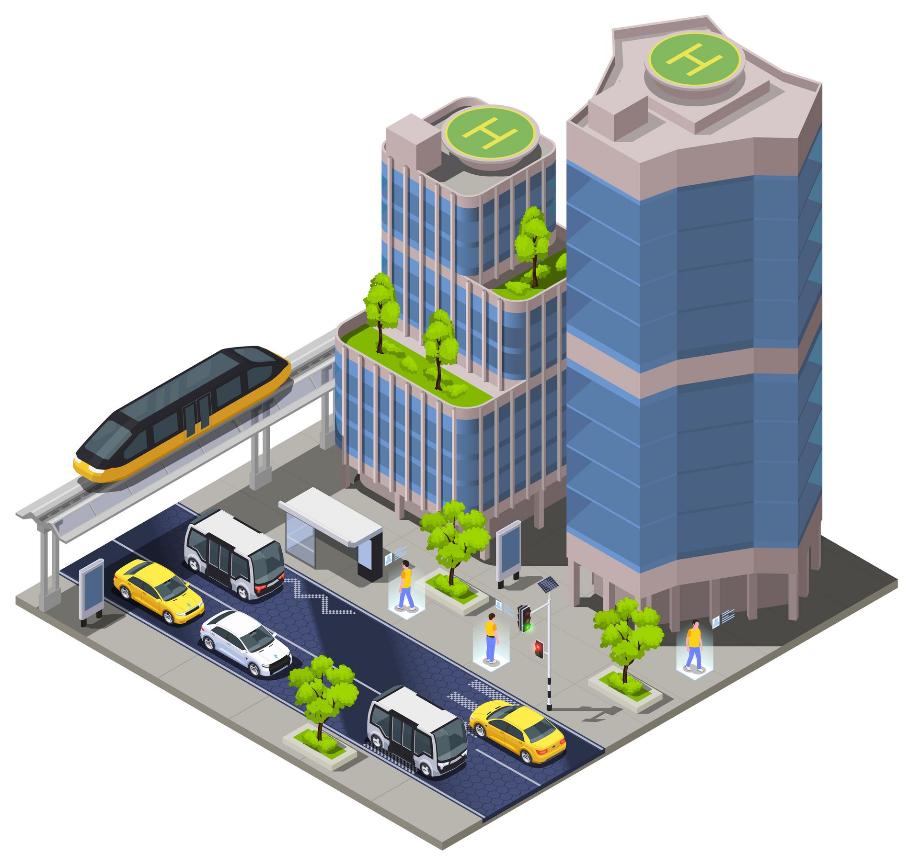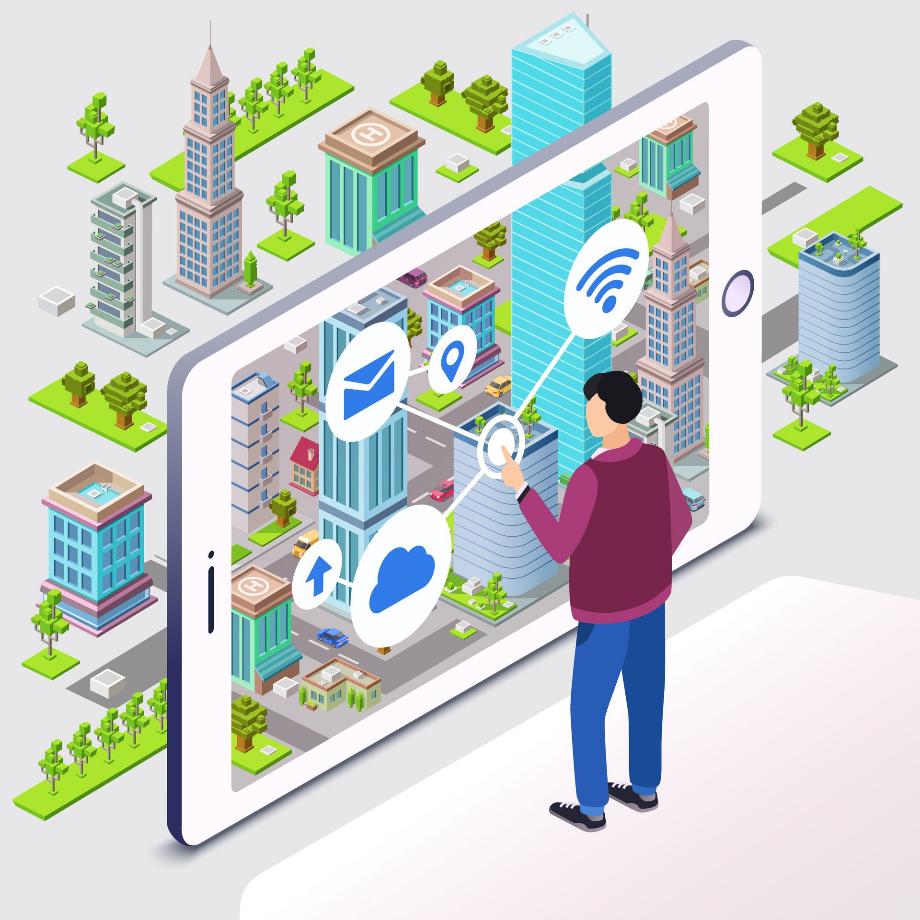Unsere Welt ist im stetigen Wandel und neue, moderne Technologien erobern schnell unseren Alltag – vielen sind wir uns gar nicht bewusst, wir benutzen sie selbstverständlich.
Im Blog "Nächste Haltestelle: Smart Society" Teil I haben wir uns bereits mit dem Begriff der Smart Society und der japanischen Interpretation dieser in Form des Projektes Society 5.0 angeschaut. Deutlich wurde, dass die Idee der ganzheitlichen Vernetzung und damit einhergehend die Möglichkeiten der Anwendung von technologischen Entwicklungen wie Robotik oder künstliche Intelligenz besonders im Hinblick auf die Problematik des demografischen Wandels einige Lösungskonzepte bereitzuhalten scheint.
Ganz aktuell im Diskurs steht die Errichtung einer sogenannten Smart City – denn die urbanen Ballungszentren werden dichter und mit ihnen wächst die Herausforderung, vorhandene und begrenzte Ressourcen möglichst clever zu nutzen. Dabei sollen die rasch voranschreitende Digitalisierung und Vernetzung genutzt und auf die uns konfrontierenden Herausforderungen unserer Zeit reagiert werden.

Der Begriff Smart City wird seit den 2000er Jahren von unterschiedlichen Akteuren in Politik, Wirtschaft, Verwaltung und insbesondere Stadtplanung verwendet und beschreibt einen ganzheitlichen Entwicklungsansatz mit dem Ziel einer effizienteren, technologisch fortschrittlicheren, nachhaltigeren und sozial inklusiveren Gestaltung urbaner Räume.
Dabei ist das Konzept als strategischer und fortschreitender Prozess zu verstehen. Bedeutend ist ebenso, dass technische, wirtschaftliche und gesellschaftliche Innovationen und deren Nutzung Teil dieses Konzeptes sind und mithilfe dieser verschiedenen Herausforderungen wie Umweltverschmutzung, Ressourcenknappheit, demografischer Wandel, Bevölkerungswachstum und Finanzkrise gemeistert werden sollen.
Funktionieren soll diese smarte Stadt, welche einfach gesagt so etwas wie Internet of Things mit intelligenten Dienstleistungen und Angeboten ist, mithilfe vieler Sensoren, Vernetzung und Daten, welche die drei Bausteine der Smart City darstellen: Die bestehende Struktur soll mit Sensoren ausgestattet werden. Diese sammeln Informationen - gespeichert und archiviert werden die Daten in einer Cloud. Durch eine umfangreiche Vernetzung verschiedener Geräte und Anwendungen können diese Daten wiederum für bestimmte Prozesse abgerufen, Zustände definiert und Daten verarbeitet werden, sodass automatisch bestimmte Handlungen ausgelöst werden. Die so entstehende permanente Interaktion zwischen den Bewohner:innen und der sie umgebenden Technologie lässt die Stadtbevölkerung zu einem Teil der Infrastruktur dieser Stadt werden.
Simple Beispiele solcher Anwendungen, die nicht nur Bestandteil einer Zukunftsversion sind, sind beispielsweise smarte Parklösungen. Sensoren auf Parkplätzen erfassen den Raum und die vorhandenen freien Plätze, sodass Nutzer:innen über eine App in Echtzeit die Daten abrufen können und wissen, auf welchem Parkplatz in der Nähe noch freie Plätze vorhanden sind. Ähnlich funktioniert auch die smarte Abfallwirtschaft, bei der Mülltonnen und Container ebenso mit Sensoren ausgestattet sind, welche wiederum stets die Füllmengen an die zuständigen Unternehmen melden. Mithilfe dieser Daten und Anwendung moderner Technologien wie künstlicher Intelligenz können die Routen der Abfallwirtschafts-Fahrzeuge schnell und individuell berechnet und angepasst werden.
Solche und weitere smarte Anwendungen betreffen nicht nur Verwaltung und Mobilität, sondern sämtliche Bereiche einer Gesellschaft. Deshalb wurden verschiedene Charakteristika einer Smart City definiert, die den Vergleich von smarten Städten vereinfachen. Diese sind Smart Economy, Smart People, Smart Governance, Smart Mobility sowie Smart Environment und Smart Living.
Eine clevere Kooperation dieser verschiedenen Aspekte soll zu einer Strategie führen, welche die heutigen Fragen und Herausforderungen unserer Gesellschaften beantworten können. Umweltfreundliche Mobilitätskonzepte, ressourcenschonende und nachhaltige Energiewirtschaft, digitalisierte Verwaltung mit umfangreichen und automatisierten Online-Diensten und auch nicht-technische Innovationen wie Share Economy sollen somit sich nicht nur positiv auf das Wirtschaftswachstum, sondern auch auf die Lebensqualität aller Bewohner:innen auswirken.

Neben den Chancen der Anwendungen einer Smart City gilt es jedoch auch, die Risiken zu durchdenken und beachten. Kritiker:innen warnen vor Missbrauch der Sensoren und so vor einer Möglichkeit der Überwachung, wie es bereits die Volksrepublik China mit ihrem Sozialkredit-System plant. Auch wird der tatsächliche Nutzen hinterfragt – dient die Technologie tatsächlich der Bevölkerung und nicht umgekehrt? Damit einhergehend ist die Frage, ob es in dem Szenario der smarten Stadt zu einem voreiligen Einsatz noch nicht ausreichend erprobter Technologien kommt und ob die Werkzeuge der smarten City nicht eher zu einer Verdummung der Bevölkerung anstatt zu einer sinnhaften Unterstützung führen.
Weitere Kritiker:innen geben zu bedenken, das Konzept der Smart City sei ein abstraktes Modell und gleiche eher einem Markt, auf dem Technologiekonzerne ihre Produkte und Dienstleistungen verkaufen können. Die Befürchtung, dass das Konzept vor allem Interessen globaler Konzerne verfolge und Menschen nur am Rande als Konsumenten vorkommen, ist unter den Kritikern weit verbreitet. Diese Sorge um unzureichende Partizipation der Bevölkerung führt zur Forderung, zivilrechtliche Initiativen müssen ebenso stark fokussiert werden wie Unternehmen.
Wie der Wandel von Städten hin zu Smart Cities gelingen kann, beschreibt beispielsweise die Broschüre "Smart City Charta - Digitale Transformation in den Kommunen nachhaltig gestalten" vom Bundesministerium für Umwelt, Naturschutz, Bau und Reaktorsicherheit. Diese Smart City Charta wurde aufbauend auf der Leipzig Charta zur nachhaltigen europäischen Stadt, der nationalen Stadtentwicklungspolitik, der Urban Agenda der Europäischen Union (Pakt von Amsterdam) und der New Urban Agenda der Vereinten Nationen entwickelt und soll die Umsetzung der Nachhaltigkeitsstrategie der Bundesrepublik Deutschland sowie die Verwirklichung der globalen Nachhaltigkeitsziele der Agenda 2030 der Vereinten Nationen fördern. Diese 2017 vorgelegte Charta soll auch dazu ermutigen, die rasch voranschreitende Digitalisierung nicht einfach ungesteuert geschehen zu lassen, sondern diese aktiv im Sinne einer zukunftsorientierten, nachhaltigen und integrierten Stadtentwicklung zu nutzen und appelliert an die transformative Kraft der Städte für das Gemeinwohl. Dazu sollen Leitlinien als Handlungsorientierung dienen und für eine ausgewogene Kooperation aller Dimensionen einer smarten Stadt sorgen.
Die Leitlinien mögen auf dem ersten Blick etwas abstrakt und grob wirken, doch sie werden in der Broschüre des Bundesministeriums ausführlich und verständlich erläutert und zeigen auf, dass die Gestaltung einer erfolgreichen Transformation hin zu einer Smart City, bei der auf Basis von integrierten Entwicklungskonzepten alle Dimensionen und Charakteristika sowie mögliche Gefahrenpotenziale ausreichend berücksichtigt werden, eine hohe Komplexität aufweist und die Kooperation verschiedener Akteure und Institutionen aus Forschung, Wirtschaft und Zivilgesellschaft benötigt.
Nächste Haltestelle: Smart Society